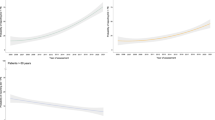Abstract
The pathogenesis of Peyronie's disease still remains an enigma and few epidemiological studies are available. The purpose of this study was to determine the prevalence of Peyronie's disease in males older than 50 y. From 26 to 30 July 1998, 1071 men attended the ‘Prostate Cancer Awareness Week of Santa Casa Hospital, Porto Alegre, Brazil’. In the prostate exam they also consented to be screened for Peyronie's disease. They underwent the 5-item International Index of Erectile Function (IIEF-5) questionnaire for evaluation of the erectile condition. The presence of a well-defined plaque in the penis was the diagnostic criterion for Peyronie's disease. The men were examined by five senior residents, under supervision by the staff Urologist. Men younger than 50 y as well as patients under intracavernous injection therapy for erectile dysfunction were excluded from the study. χ2 test was used for statistical analysis. Nine hundred and fifty-four (89.1%) out of the 1071 men with a mean age of 62 y (ranging from 52 to 77) were included in the study. Peyronie's disease plaques were found in 35 men (3.67%). Eight hundred and forty-five (88.6%) were Caucasians. There was no significant statistical difference regarding age (P>0.05). The presence of erectile dysfunction in the men with Peyronie's disease and without this condition, was 68.6% and 53.5%, respectively (P>0.05). From this data we can conclude that the prevalence of Peyronie's disease is higher than in formerly reported studies. Further observations should be carried out in different communities and in other groups of patients in order to confirm our results.
This is a preview of subscription content, access via your institution
Access options
Subscribe to this journal
Receive 8 print issues and online access
$259.00 per year
only $32.38 per issue
Buy this article
- Purchase on Springer Link
- Instant access to full article PDF
Prices may be subject to local taxes which are calculated during checkout
Similar content being viewed by others
References
Lowe FC, Brendler CB . Evaluation of the urologic patient. History physical examination, and urinalysis. In: Walsh PC, Retik AB, Stamey TA, Vaughan ED (eds). Campbell's Urology 6th Edition. WB Saunder Company: Philadelphia, PA 1992 chapter 8, 307–342
Rehman J, Benet A, Melman A . Use of intralesional verapamil to dissolve Peyronie's disease plaque: a long-term single-blind study. Urology 1998 51, 620–626
Schiavino D et al.. Imunologic findings in Peyronie's disease: a controlled study. Urology 1997 50, 766–768
Leffel MS . Is there an immunogenetic basis for Peyronie's disease? J Urol 1997 157, 295–297
El-Sakka AI et al.. Peyronie's disease is associated with an increase in transforming growth factor-B protein expression. J Urol 1997 158, 1391–1394
Chilton CP, Castle WM, Westwood CA, Pryor JP . Factors associated in the aetiology of Peyronie's disease. Br J Urol 1982 54, 748–750
Ralph DJ, Brooks MD, Bottazzo GF, Pryor JP . The treatment of Peyronie's disease with tamoxifen. Br J Urol 1992 70, 648–651
Rhoden EL et al.. Is there any association between Peyronie's disease and serum collagen markers? Int J Impot Res 2000 12, 302–304
Jordan GH, Schlossberg SM, Devine CJ . Surgery of the penis and urethra. In: Walsh PC, Retik AB, Vaughan ED, Wein AJ (eds). Campbell's Urology, 7th edition. WB Sauders Company: Philadelphia, PA 1998 3, Chap 107, 3316–3394
Schwarzer U et al.. Prevalence of Peyronie's disease—results of an 8,000 men survey. AUA 2000 Annual Meeting.
Rosen RC, Cappelleri JC, Lipsky J, Peña BM . Development and evaluation of an abridged, 5-item version of the International Index of Erectile Function (IIEF-5) as a diagnostic tool for erectile dysfunction. Int J Impot Res 1999 11, 319–326
Rosen RC et al.. The International Index of Erectile Function (IIEF): a multidimensional scale for assessment of erectile dysfunction. Urology 1997 49, 822–830
Iacono F et al.. Microstructural disorders of the tunica albuginea in patients affected by Peyronie's disease with or without erection dysfunction. J Urol 1993 150, 1806–1809
Dunsmuir WD . Francois de LaPeyronie (1678–1747): the man and the disease he described. Br J Urol 1996 78, 613–622
Telöken C et al.. Tamoxifen versus placebo in the treatment of Peyronie's disease. J Urol 1999 162, 2003–2005
Devine CJ, Jordan GH, Shlossberg SM . Surgery of the penis and urethra. In: Walsh PC, Retik AB, Stamey TA, Vaughan ED (eds). Campbell's Urology, 6th edition. WB Saunder Company: Philadelphia, PA 1992 Chapter 83, 2957–3032
Altaffer LF, Jordan GH . Sonographic demonstration of Peyronie's disease. Urology 1981 27, 292–295
Smith BH . Subclinical Peyronie's disease. Am J Path 1969 52, 385–390
Lindsay MB et al.. The incidence of Peyronie's disease in Rochester, Minnesota 1950 through 1984. J Urol 1991 146, 1007–1009
Author information
Authors and Affiliations
Corresponding author
Rights and permissions
About this article
Cite this article
Rhoden, E., Teloken, C., Ting, H. et al. Prevalence of Peyronie's disease in men over 50-y-old from Southern Brazil. Int J Impot Res 13, 291–293 (2001). https://doi.org/10.1038/sj.ijir.3900727
Received:
Revised:
Accepted:
Published:
Issue Date:
DOI: https://doi.org/10.1038/sj.ijir.3900727
Keywords
This article is cited by
-
Validation of the Italian version of the Peyronie’s Disease Questionnaire (PDQ)
International Journal of Impotence Research (2023)
-
Conservative management of suspected fractures in men undergoing collagenase clostridium histolyticum for Peyronie’s Disease is not associated with worsening of erectile function
International Journal of Impotence Research (2022)
-
Peyronie’s Disease Questionnaire (PDQ): Spanish translation and validation
International Journal of Impotence Research (2022)
-
Penile Plication in Peyronie’s Disease: Technique Evolution and Recent Advances
Current Sexual Health Reports (2021)
-
Patient perspectives on Peyronie’s disease: results of poststudy interviews from a phase 2 trial of collagenase clostridium histolyticum
International Journal of Impotence Research (2019)


